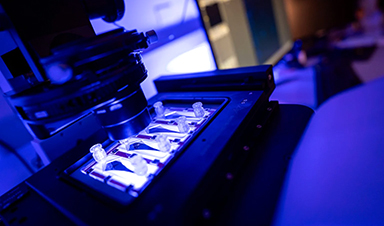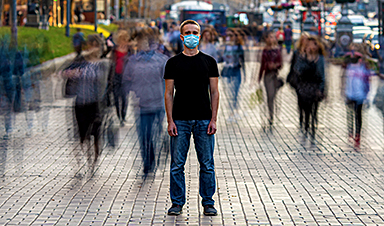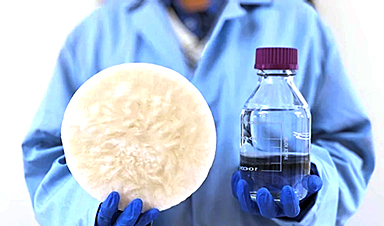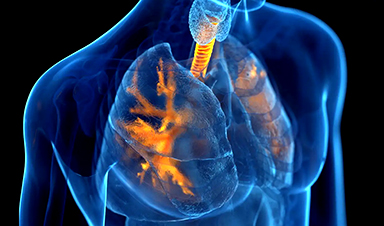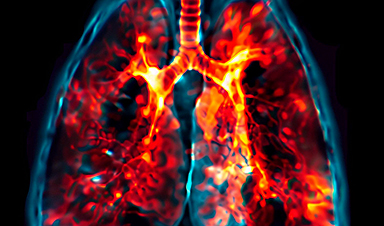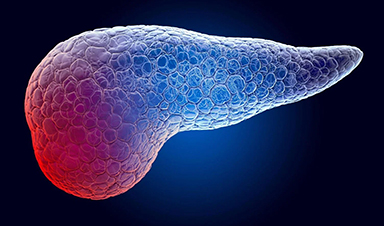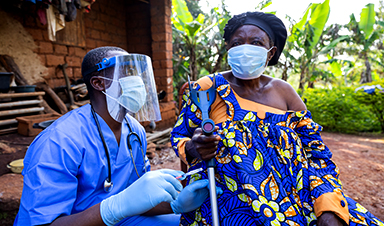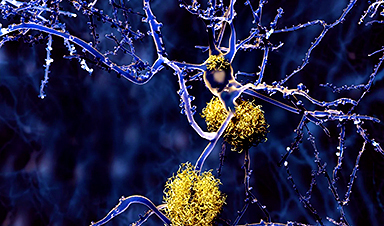Results from a Scripps Research and UNC team pave the way for a vaccine and therapeutic antibodies that could be stockpiled to fight future coronavirus pandemics.
A team of scientists from Scripps Research and the University of North Carolina (UNC) has found antibodies in the blood of certain COVID-19 donors that can block infection from a broad set of coronaviruses—specifically, in people who have recovered from the virus and were then vaccinated. They found this includes not only the COVID-19-causing SARS-CoV-2, but also SARS-CoV-1 and MERS-CoV.
The scientists’ detailed study of the antibodies and their virus binding sites, reported on February 15, 2023, in the journal Immunity, could lead to the development of a broad coronavirus vaccine and related antibody therapeutics. Both could be used against future coronavirus pandemics as well as any future variants of SARS-CoV-2.
The other Scripps Research co-senior authors were Dennis Burton, PhD, professor and James and Jessie Minor Chair of the Department of Immunology and Microbiology, and Ian Wilson, PhD, Hansen Professor of Structural Biology and chair of the Department of Integrative Structural and Computational Biology. The co-senior authors from UNC were professor Ralph Baric, PhD, and assistant professor Lisa Gralinski, PhD.
SARS-CoV-2, along with SARS-CoV-1 (the cause of the 2002-04 SARS outbreak) and MERS-CoV (the cause of deadly Middle East Respiratory Syndrome), belong to a broad grouping of coronaviruses known as betacoronaviruses. These viruses mutate at a modestly high rate, creating a significant challenge for the development of vaccines and antibody therapies against them. Thus, in the case of SARS-CoV-2, although existing vaccines have been very helpful in limiting the toll of disease and death from the pandemic, new SARS-CoV-2 variants have emerged that can spread even among vaccine recipients.
Over the past two years, however, the Andrabi/Burton and Wilson laboratories have been finding evidence that SARS-CoV-2 and other betacoronaviruses have a vulnerable site that does not mutate much. This site, which is in the S2 region (or base) of the viral spike protein, is relatively conserved on betacoronaviruses that infect a variety of animal species. By contrast, current SARS-CoV-2 vaccines mainly target the viral spike protein’s relatively mutable S1 region, with which the virus binds to host-cell receptors.
The S2 site plays a key role in how betacoronaviruses progress from receptor-binding to the membrane fusion that enables entry into host cells in the respiratory tract. In a study reported last year, the Andrabi/Burton and Wilson laboratories found that some human antibodies can bind to this site on SARS-CoV-2 in a way that apparently disrupts viral fusion and blocks infection. The existence of such a vulnerable site raises the possibility of targeting it to provide both long-lasting and broad protection against betacoronaviruses. Therefore, the researchers, for the new study, made a more comprehensive search for anti-S2 antibodies in blood samples from human volunteers.
These volunteers were individuals who had recovered from COVID-19, had been vaccinated, or had recovered from COVID-19 and then had been vaccinated. Somewhat to the researchers’ surprise, they found that antibodies to the vulnerable S2 site were present in the vast majority of volunteers in the latter group—people who had recovered from COVID-19 and then had been vaccinated—but at a much lower frequency in the others. Overall, the researchers identified and characterized 32 of these S2-targeting antibodies.
In lab virus neutralization studies and in virus-challenge studies with mice at UNC, the researchers found that several of these antibodies provide protection of unprecedented breadth— not only against SARS-CoV-2 but also SARS-CoV-1 and MERS-CoV betacoronaviruses.
“In principle, a vaccination strategy that can induce such antibodies is likely to provide broad protection against a diverse spectrum of betacoronaviruses,” says Burton.
Structural studies of several of the antibodies when bound to S2 illuminated their common binding sites and modes of binding, providing key information that should aid the development of future vaccines targeting this region.
“Targeted rational vaccine strategies could take advantage of this molecular information of the interactions of these antibodies with the S2 domain to inform the design of pan-betacoronavirus vaccines,” says Wilson.
Indeed, the researchers have already applied their findings to the initial design and testing of a potential “pan-betacoronavirus” vaccine candidate, which if successful could be stockpiled to limit future pandemics. The investigators also envision a therapeutic mix of different S2-targeting antibodies, perhaps as a cocktail with antibodies to other spike regions, that could be taken to prevent infection by a novel betacoronavirus or to reduce disease in those already infected.
News
Baffling Scientists for Centuries: New Study Unravels Mystery of Static Electricity
ISTA physicists demonstrate that contact electrification depends on the contact history of materials. For centuries, static electricity has intrigued and perplexed scientists. Now, researchers from the Waitukaitis group at the Institute of Science and [...]
Tumor “Stickiness” – Scientists Develop Potential New Way To Predict Cancer’s Spread
UC San Diego researchers have developed a device that predicts breast cancer aggressiveness by measuring tumor cell adhesion. Weakly adherent cells indicate a higher risk of metastasis, especially in early-stage DCIS. This innovation could [...]
Scientists Just Watched Atoms Move for the First Time Using AI
Scientists have developed a groundbreaking AI-driven technique that reveals the hidden movements of nanoparticles, essential in materials science, pharmaceuticals, and electronics. By integrating artificial intelligence with electron microscopy, researchers can now visualize atomic-level changes that were [...]
Scientists Sound Alarm: “Safe” Antibiotic Has Led to an Almost Untreatable Superbug
A recent study reveals that an antibiotic used for liver disease patients may increase their risk of contracting a dangerous superbug. An international team of researchers has discovered that rifaximin, a commonly prescribed antibiotic [...]
Scientists Discover Natural Compound That Stops Cancer Progression
A discovery led by OHSU was made possible by years of study conducted by University of Portland undergraduates. Scientists have discovered a natural compound that can halt a key process involved in the progression [...]
Scientists Just Discovered an RNA That Repairs DNA Damage – And It’s a Game-Changer
Our DNA is constantly under threat — from cell division errors to external factors like sunlight and smoking. Fortunately, cells have intricate repair mechanisms to counteract this damage. Scientists have uncovered a surprising role played by [...]
What Scientists Just Discovered About COVID-19’s Hidden Death Toll
COVID-19 didn’t just claim lives directly—it reshaped mortality patterns worldwide. A major international study found that life expectancy plummeted across most of the 24 analyzed countries, with additional deaths from cardiovascular disease, substance abuse, and mental [...]
Self-Propelled Nanoparticles Improve Immunotherapy for Non-Invasive Bladder Cancer
A study led by Pohang University of Science and Technology (POSTECH) and the Institute for Bioengineering of Catalonia (IBEC) in South Korea details the creation of urea-powered nanomotors that enhance immunotherapy for bladder cancer. The nanomotors [...]
Scientists Develop New System That Produces Drinking Water From Thin Air
UT Austin researchers have developed a biodegradable, biomass-based hydrogel that efficiently extracts drinkable water from the air, offering a scalable, sustainable solution for water access in off-grid communities, emergency relief, and agriculture. Discarded food [...]
AI Unveils Hidden Nanoparticles – A Breakthrough in Early Disease Detection
Deep Nanometry (DNM) is an innovative technique combining high-speed optical detection with AI-driven noise reduction, allowing researchers to find rare nanoparticles like extracellular vesicles (EVs). Since EVs play a role in disease detection, DNM [...]
Inhalable nanoparticles could help treat chronic lung disease
Nanoparticles designed to release antibiotics deep inside the lungs reduced inflammation and improved lung function in mice with symptoms of chronic obstructive pulmonary disease By Grace Wade Delivering medication to the lungs with inhalable nanoparticles [...]
New MRI Study Uncovers Hidden Lung Abnormalities in Children With Long COVID
Long COVID is more than just lingering symptoms—it may have a hidden biological basis that standard medical tests fail to detect. A groundbreaking study using advanced MRI technology has uncovered significant lung abnormalities in [...]
AI Struggles with Abstract Thought: Study Reveals GPT-4’s Limits
While GPT-4 performs well in structured reasoning tasks, a new study shows that its ability to adapt to variations is weak—suggesting AI still lacks true abstract understanding and flexibility in decision-making. Artificial Intelligence (AI), [...]
Turning Off Nerve Signals: Scientists Develop Promising New Pancreatic Cancer Treatment
Pancreatic cancer reprograms nerve cells to fuel its growth, but blocking these connections can shrink tumors and boost treatment effectiveness. Pancreatic cancer is closely linked to the nervous system, according to researchers from the [...]
New human antibody shows promise for Ebola virus treatment
New research led by scientists at La Jolla Institute for Immunology (LJI) reveals the workings of a human antibody called mAb 3A6, which may prove to be an important component for Ebola virus therapeutics. [...]
Early Alzheimer’s Detection Test – Years Before Symptoms Appear
A new biomarker test can detect early-stage tau protein clumping up to a decade before it appears on brain scans, improving early Alzheimer’s diagnosis. Unlike amyloid-beta, tau neurofibrillary tangles are directly linked to cognitive decline. Years [...]


